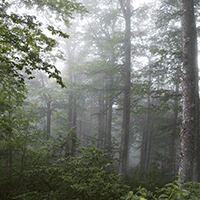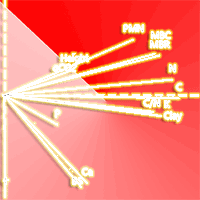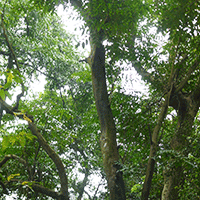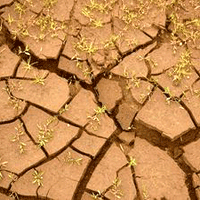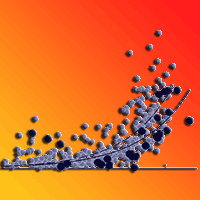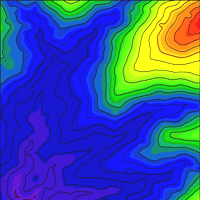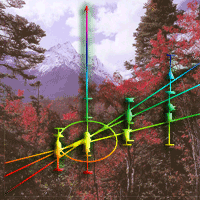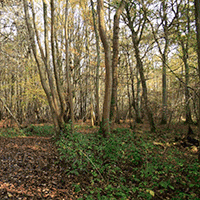Black locust is a tree species considered suitable for afforestation in Turkey because of its rapid growth and ability to fix atmospheric nitrogen in disturbed soil ecosystems. Quantitative indicators of soil health and quality can be usefully derived from a data set of soil physical, chemical and microbial characteristics. In this study changes in soil characteristics after afforestation with black locust were assessed by comparing several afforestation sites with control (no vegetation) sites randomly chosen along the roadside in Ulus-Bartin, the western Black Sea region (Turkey). Results showed that some physical and chemical characteristics of the soil (soil bulk density, clay content, soil organic C and total N) were higher at the afforestation sites as compared with the control sites. Similarly, afforestation sites showed higher values for mean soil microbial biomass C (afforestation: 311.97 µg g-1;control: 149.68 µg g-1) and N (afforestation: 43.07 µg g-1; control: 19.21 µg g-1), and basal respiration (afforestation: 0.303 µg CO2-C g-1 h-1; control: 0.167 µg CO2-C g-1 h-1). However, the mean metabolic quotient (qCO2) assessed at the control sites was higher (1.47 mg CO2-C g-1 Cmic h-1) than that observed the afforestation sites (0.96 mg CO2-C g-1 Cmic h-1), likely due to difficulties in the utilization of organic substrates by the microbial community. In addition, the correlation between the qCO2 and Cmic/Corg percentages was negative (r = - 0.586, P < 0.01) in both sites. Our results indicated that afforestation with black locust could be advantageous, not only for soil improvement and regeneration, but also for sustainable land management.
Keywords
, , , ,
Citation
Bolat I, Kara Ö, Sensoy H, Yüksel K (2015). Influences of Black Locust (Robinia pseudoacacia L.) afforestation on soil microbial biomass and activity. iForest 9: 171-177. - doi: 10.3832/ifor1410-007
Academic Editor
Gianfranco Minotta
Paper history
Received: Jul 27, 2014
Accepted: Oct 16, 2014
First online: Feb 16, 2015
Publication Date: Feb 21, 2016
Publication Time: 4.10 months
© SISEF - The Italian Society of Silviculture and Forest Ecology 2015
Open Access
This article is distributed under the terms of the Creative Commons Attribution-Non Commercial 4.0 International (https://creativecommons.org/licenses/by-nc/4.0/), which permits unrestricted use, distribution, and reproduction in any medium, provided you give appropriate credit to the original author(s) and the source, provide a link to the Creative Commons license, and indicate if changes were made.

Breakdown by View Type
(Waiting for server response...)
Article Usage
Total Article Views: 56157
(from publication date up to now)
Breakdown by View Type
HTML Page Views: 46049
Abstract Page Views: 3906
PDF Downloads: 4694
Citation/Reference Downloads: 41
XML Downloads: 1467
Web Metrics
Days since publication: 3949
Overall contacts: 56157
Avg. contacts per week: 99.54
Article Citations
Article citations are based on data periodically collected from the Clarivate Web of Science web site
(last update: Mar 2025)
Total number of cites (since 2016): 26
Average cites per year: 2.60
Publication Metrics
by Dimensions ©
Articles citing this article
List of the papers citing this article based on CrossRef Cited-by.
(1)
Alef K (1995)Soil respiration. In: “Methods in applied soil microbiology and biochemistry” (Alef P, Nannipieri K eds). Academic Press, London, UK, pp. 214-218.
Gscholar
(2)
Anderson TH, Domsch KH (1986)Carbon link between microbial biomass and soil organic matter. In: “Perspectives in microbial ecology” (Megusar F, Gantar M eds). Slovene Society for Microbiology, Ljubljana, Mladinska knjiga, pp. 467-471.
Gscholar
(3)
Anderson JPE, Domsch KH (1989)Ratios of microbial biomass carbon to total organic carbon in arable soils. Soil Biology and Biochemistry 21: 471-479.
CrossRef |
Gscholar
(4)
Anderson TH, Domsch KH (1990)Application of eco-physiological quotients (qCO2, and qD) on microbial biomasses from soils of different cropping histories. Soil Biology and Biochemistry 22: 251-255.
CrossRef |
Gscholar
(5)
Anderson JM, Ingram JSI (1996)Tropical soil biology and fertility: a handbook of methods (2nd edn). CAB International, Wallingford, UK, pp. 68-70.
Gscholar
(6)
Anderson TH (2003)Microbial eco-physiological indicators to assess soil quality. Agriculture Ecosystems and Environment 98: 285-293.
CrossRef |
Gscholar
(7)
Ansin R, Özkan ZC (1997)Seed plants (Spermatophyta): woody taxons. Karadeniz Technical University Publication No. 167, Forest Faculty Publication No. 19, Trabzon, Turkey, pp. 449-452. [in Turkish]
Gscholar
(8)
Araujo ASF, Silva EFL, Nunes LAPL, Carneiro RFV (2010)The effect of converting tropical native savanna to
Eucalyptus grandis forest on soil microbial biomass. Land Degradation and Development 21 (6): 540-545.
CrossRef |
Gscholar
(9)
Balota EL, Colozzi-Filho A, Andrade DS, Dick RP (2003)Microbial biomass in soils under different tillage and crop rotation systems. Biology and Fertility of Soils 38: 15-20.
CrossRef |
Gscholar
(10)
Balota EL, Yada IF, Amaral H, Nakatani AS, Dick RP, Coyne MS (2013)Long- term land use influences soil microbial biomass P and S, phosphatase and arylsulfatase activities, and S mineralization in a Brazilian oxisol. Land Degradation and Development.
CrossRef |
Gscholar
(11)
Bastida F, Zsolnay A, Hernández T, García C (2008)Past, present and future of soil quality indices: a biological perspective. Geoderma 147 (3): 159-171.
CrossRef |
Gscholar
(12)
Bauhus JD, Pare D, Cote L (1998)Effects of tree species, stand age, and soil type on soil microbial biomass and its activity in a southern boreal forest. Soil Biology and Biochemistry 30: 1077-1089.
CrossRef |
Gscholar
(13)
Bauhus J, Khanna PK (1999)The significance of microbial biomass in forest soils. In: “Going underground-ecological studies in forest soils” (Rastin N, Bauhus J eds). Research Signpost, Trivandrum, India, pp. 77-110.
Online |
Gscholar
(14)
Blake GR, Hartge KH (1986)Bulk density. In: “Methods of Soil Analysis, Part 1. Physical and Mineralogical Methods” (Klute A ed). Agronomy Monograph 9, American Society of Agronomy-Soil Science Society of America, Madison, WI, USA, pp. 363-375.
Gscholar
(15)
Bolat I (2014)The effect of thinning on microbial biomass C, N and basal respiration in black pine forest soils in Mudurnu, Turkey. European Journal of Forest Research 133: 131-139.
CrossRef |
Gscholar
(16)
Bouyoucos GJ (1962)Hydrometer method improved for making particle size analyses of soils. Agronomy Journal 54: 464-465.
CrossRef |
Gscholar
(17)
Brady NC (1990)The nature and properties of soils (10th edn). Macmillan, NY, USA, pp. 621.
Gscholar
(18)
Brookes PC, Landman A, Pruden G, Jenkinson DS (1985)Chloroform fumigation and the release of soil nitrogen: a rapid extraction metod to measure microbial biomass nitrogen in soil. Soil Biology and Biochemistry 17: 837-842.
CrossRef |
Gscholar
(19)
Campbell CA, McConkey BG, Zentner RP, Selles F, Curtin D (1996)Long-term effects of tillage and crop rotations on soil organic C and total N in a clay soil in southwestern Saskatchewan. Canadian Journal of Soil Science 76: 395-401.
CrossRef |
Gscholar
(20)
Campos AC, Etchevers JB, Oleschko KL, Hidalgo CM (2012)Soil microbial biomass and nitrogen mineralization rates along an altitudinal gradient on the Cofre De Perote Volcano (Mexico): the importance of landscape position and land use. Land Degradation and Development.
CrossRef |
Gscholar
(21)
Cheng YB, Xia YD (2012)Soil microbial and enzymatic activities across a chronosequence of Chinese Pine plantation development on the Loess Plateau of China. Pedosphere 22 (1): 1-12.
CrossRef |
Gscholar
(22)
Cierjacks A, Kowarik I, Joshi J, Hempel S, Ristow M, Lippe M, Weber E (2013)Biological flora of the British Isles:
Robinia pseudoacacia. Journal of Ecology 101 (6): 1623-1640.
CrossRef |
Gscholar
(23)
Danso SKA, Zapata F, Awonaike KO (1995)Measurement of biological N
2 fixation in field-grown
Robinia pseudoacacia L. Soil Biology and Biochemistry 27: 415-419.
CrossRef |
Gscholar
(24)
Diekow J, Mielniczuk J, Knicker H, Bayer C, Dick DP, Kögel-Knabner I (2005)Soil C and N stocks as affected by cropping systems and nitrogen fertilisation in a southern Brazil Acrisol managed under no-tillage for 17 years. Soil and Tillage Research 81: 87-95.
CrossRef |
Gscholar
(25)
English NB, Weltzin JF, Fravolini A, Thomas L, Williams DG (2005)The influence of soil texture and vegetation on soil moisture under rainout shelters in a semi-desert grassland. Journal of Arid Environment 63: 324-343.
CrossRef |
Gscholar
(26)
Ferreira ACC, Leite LFC, Araújo ASF, Eisenhauer N (2014)Land-use type effects on soil organic carbon and microbial properties in a semi-arid region of northeast Brazil. Land Degradation and Development (early view).
CrossRef |
Gscholar
(27)
Fterich A, Mahdhi M, Mars M (2014)The effects of Acacia tortilis subsp. raddiana, soil texture and soil depth on soil microbial and biochemical characteristics in arid zones of Tunisia. Land Degradation and Development 25: 143-152.
CrossRef |
Gscholar
(28)
García-Orenes F, Guerrero C, Roldán A, Mataix-Solera J, Cerdà A, Campoy M, Zornoza R, Bárcenas G, Caravaca F (2010)Soil microbial biomass and activity under different agricultural management systems in a semiarid Mediterranean agroecosystem. Soil and Tillage Research 109 (2): 110-115.
CrossRef |
Gscholar
(29)
Guénon R, Vennetier M, Dupuy N, Roussos S, Pailler A, Gros R (2013)Trends in recovery of Mediterranean soil chemical properties and microbial activities after infrequent and frequent wildfires. Land Degradation and Development 24 (2): 115-128.
CrossRef |
Gscholar
(30)
Haris JA (2003)Measurements of the soil microbial community for estimating the success of restoration. European Journal of Soil Science 54: 801-808.
CrossRef |
Gscholar
(31)
Insam H, Mitchell CC, Dormaar JF (1991)Relationship of soil microbial biomass and activity with fertilization practice and crop yield of three ultisols. Soil Biology and Biochemistry 23 (5): 459-464.
CrossRef |
Gscholar
(32)
Islam KR, Weil RR (2000)Land use effects on soil quality in a tropical forest ecosystem of Bangladesh. Agriculture, Ecosystems and Environment 79: 9-16.
CrossRef |
Gscholar
(33)
Jenkinson DS, Ladd JN (1981)Microbial biomass in soil measurement and turnover. In: “Soil biochemistry, vol. 5” (Paul EA, Ladd JN eds). Marcel Dekker Inc, New York and Basel, USA, pp. 415-471.
Gscholar
(34)
Jenkinson DS (1988)The determination of microbial biomass carbon and nitrogen in soil. In: “Advances in nitrogen cycling in agricultural ecosystems” (Wilson JR ed). CAB, Wallingford, UK, pp. 368-386.
Gscholar
(35)
Johansson M-B (1995)The chemical composition of needle and leaf litter from Scots pine, Norway spruce and white birch in Scandinavian forests. Forestry 68: 49-62.
CrossRef |
Gscholar
(36)
Kara O, Bolat I (2008)Soil microbial biomass C and N changes in relation to forest conversion in the northwestern Turkey. Land Degradation and Development 19 (4): 421-428.
CrossRef |
Gscholar
(37)
Kara O, Sensoy H, Bolat I (2010)Slope length effects on microbial biomass and activity of eroded sediments. Journal of Soils and Sediments 10 (3): 434-439.
CrossRef |
Gscholar
(38)
Keskin T, Makineci E (2009)Some soil properties on coal mine spoils reclaimed with black locust (
Robinia pceudoacacia L.) and umbrella pine (
Pinus pinea L.) in Agacli-Istanbul. Environmental Monitoring and Assessment 159 (1-4): 407-414.
CrossRef |
Gscholar
(39)
Khan KS, Joergensen G (2006)Microbial C, N and P relationships in moisture stressed soils of Potohar, Pakistan. Journal of Plant Nutrition and Soil Science 169: 494-500.
CrossRef |
Gscholar
(40)
Landgraf D, Wedig S, Klose S (2005)Medium-and short-term available organic matter, microbial biomass, and enzyme activities in soils under
Pinus sylvestris L. and
Robinia pseudoacacia L. in a sandy soil in NE Saxony, Germany. Journal of Plant Nutrition and Soil Science 168 (2): 193-201.
CrossRef |
Gscholar
(41)
Liao JD, Boutton TW (2008)Soil microbial biomass response to woody plant invasion of grassland. Soil Biology and Biochemistry 40: 1207-1216.
CrossRef |
Gscholar
(42)
Lovett GM, Weathers KC, Arthur MA (2002)Control of nitrogen loss from forested watersheds by soil carbon: nitrogen ratio and tree species composition. Ecosystems 5 (7): 712-718.
CrossRef |
Gscholar
(43)
McGill WB, Cannon KR, Robertson JA, Cook FD (1986)Dynamics of soil microbial biomass and water-soluble organic C in Breton L after 50 years of cropping to two rotations. Canadian Journal of Soil Science 66: 1-19.
CrossRef |
Gscholar
(44)
Noh NJ, Son Y, Koo JW, Seo KW, Kim RH, Lee YY, Yoo KS (2010)Comparison of nitrogen fixation for north- and south-facing Robinia pseudoacacia stands in Central Korea. Journal of Plant Biology 53: 61-69.
CrossRef |
Gscholar
(45)
Nsabimana D, Haynes RJ, Wallis FM (2004)Size, activity and catabolic diversity of the soil microbial biomass as affected by land use. Applied Soil Ecology 26: 81-92.
CrossRef |
Gscholar
(46)
Oostra S, Majdi H, Olsson M (2006)Impact of tree species on soil carbon stocks and soil acidity in southern Sweden. Scandinavian Journal of Forest Research 21 (5): 364-371.
CrossRef |
Gscholar
(47)
Pereira EL, Santos SAP, Arrobas M, Patricio MS (2011)Microbial biomass and N mineralization in mixed plantations of broadleaves and nitrogen-fixing species. Forest Systems 20: 516-524.
CrossRef |
Gscholar
(48)
Powlson DS, Brookes PC, Christensen BT (1987)Measurement of soil microbial biomass provides an early indication of changes in the total soil organic matter due to straw incorporation. Soil Biology and Biochemistry 19: 159-164.
CrossRef |
Gscholar
(49)
Qiu L, Zhang X, Cheng J, Yin X (2010)Effects of black locust (
Robinia pseudoacacia) on soil properties in the loessial gully region of the Loess Plateau, China. Plant and Soil 332: 207-217.
CrossRef |
Gscholar
(50)
Rice SK, Westerman B, Federici R (2004)Impacts of the exotic, nitrogen-fixing black locust (
Robinia pseudoacacia) on nitrogen-cycling in a pine-oak ecosystem. Plant Ecology 174: 97-107.
CrossRef |
Gscholar
(51)
Rowell DL (1994)Soil science: methods and applications. Longman Publishers (Pte) Ltd, Singapore, pp. 350.
Gscholar
(52)
Sabo AE (2000)Robinia pseudoacacia invasions and control in North America and Europe. Restoration and Reclamation Review 6 (3): 1-9.
Online |
Gscholar
(53)
Sparling GP (1997)Soil microbial biomass, activity and nutrient cycling as indicators of soil health. In: “Biological indicators of soil health” (Pankhurst CE, Doube BM, Gupta VVSR eds). CAB International, Wallingford, UK, pp. 97-119.
Online |
Gscholar
(54)
Sumner ME (1995)Sodic soils: new perspectives. In: “Australian Sodic Soils: Distribution, Properties and Management” (Naidu R, Sumner ME, Rengasamy P eds). CSIRO, Melbourne, Australia, pp. 1-34.
CrossRef |
Gscholar
(55)
Tateno R, Tokuchi N, Yamanaka N, Du S, Otsuki K, Shimamura T, Xue Z, Wang S, Hou Q (2007)Comparison of litterfall production and leaf litter decomposition between an exotic black locust plantation and an indigenous oak forest near Yan’an on the Loess Plateau, China. Forest Ecology and Management 241: 84-90.
CrossRef |
Gscholar
(56)
Thornthwaite CW (1948)An approach toward a rational classification of climate. The Geographical Review 38: 55-94.
CrossRef |
Gscholar
(57)
TSMS (2013)Daily meteorological data. The Turkish State Meteorological Service, Ankara, Turkey, web site. [online]
Online |
Gscholar
(58)
Ussiri DAN, Lal R, Jacinthe PA (2006)Soil properties and carbon sequestration of afforested pastures in reclaimed minesoils of Ohio. Soil Science Society of America Journal 70: 1797-1806.
CrossRef |
Gscholar
(59)
Vance ED, Brookes PC, Jenkinson DS (1987)An extraction method for measuring soil microbial biomass C. Soil Biology and Biochemistry 19: 703-707.
CrossRef |
Gscholar
(60)
Vitousek PM, Walker LR (1989)Biological invasion by
Myrica faya in Hawaii: plant demography, nitrogen fixation and ecosystem effects. Ecological Monographs 59: 247-265.
CrossRef |
Gscholar
(61)
Wang B, Liu G, Xue S (2012)Effect of black locust (
Robinia pseudoacacia) on soil chemical and microbiological properties in the eroded hilly area of China’s Loess Plateau. Environmental Earth Sciences 65 (3): 597-607.
CrossRef |
Gscholar
(62)
Wardle DA (1992)A comparative assessment of factors which influence microbial biomass carbon and nitrogen levels in soil. Biology Reviews 67: 321-358.
CrossRef |
Gscholar
(63)
Wardle DA (1993)Changes in the microbial biomass and metabolic quotient during leaf litter succession in some New Zealand forest and scrubland ecosystems. Functional Ecology 7: 346-355.
CrossRef |
Gscholar
(64)
Winding A, Hund-Rinke K, Rutgers M (2005)The use of microorganisms in ecological soil classification and assessment concepts. Ecotoxicology and Environmental Safety 62: 230-248.
CrossRef |
Gscholar
(65)
Xue S, Liu G, Dai Q, Wei W, Hou X (2007)Evolution of soil microbial biomass in the restoration process of artificial
Robinia pseudoacacia under erosion environment. Acta Ecologica Sinica 27: 909-917.
Gscholar
(66)
Yüksek T (2012)The restoration effects of black locust (
Robinia pseudoacacia L) plantation on surface soil properties and carbon sequestration on lower hillslopes in the semi-humid region of Coruh Drainage Basin in Turkey. Catena 90: 18-25.
CrossRef |
Gscholar
(67)
Zeller B, Colin-Belgrand M, Dambrine E, Martin F, Bottner P (2000)Decomposition of
15N-labelled beech litter and fate of nitrogen derived from litter in a beech forest. Oecologia 123: 550-559.
CrossRef |
Gscholar
(68)
Zhao Z, Shahrour I, Bai Z, Fan W, Feng L, Li H (2013)Soils development in opencast coal mine spoils reclaimed for 1-13 years in the West-Northern Loess Plateau of China. European Journal of Soil Biology 55: 40-46.
CrossRef |
Gscholar
(69)
Zhou ZC, Shangguan ZP (2005)Soil anti-scouribility enhanced by plant roots. Journal of Integrative Plant Biology 47: 676-682.
CrossRef |
Gscholar


